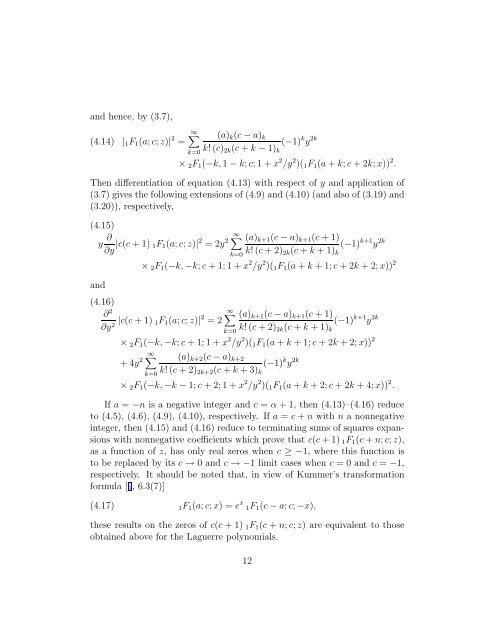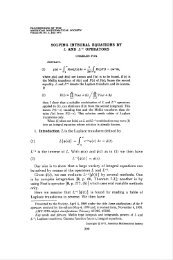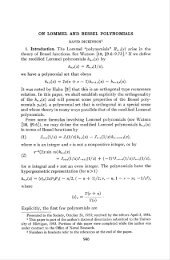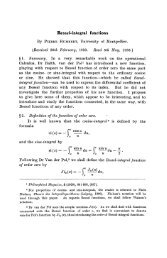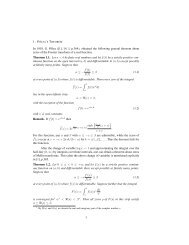G. Gasper Using sums of squares to prove that ... - Fuchs-braun.com
G. Gasper Using sums of squares to prove that ... - Fuchs-braun.com
G. Gasper Using sums of squares to prove that ... - Fuchs-braun.com
You also want an ePaper? Increase the reach of your titles
YUMPU automatically turns print PDFs into web optimized ePapers that Google loves.
and hence, by (3.7),<br />
(4.14) | 1 F 1 (a; c; z)| 2 =<br />
∞∑<br />
k=0<br />
(a) k (c − a) k<br />
k! (c) 2k (c + k − 1) k<br />
(−1) k y 2k<br />
× 2 F 1 (−k, 1 − k; c; 1 + x 2 /y 2 )( 1 F 1 (a + k; c + 2k; x)) 2 .<br />
Then differentiation <strong>of</strong> equation (4.13) with respect <strong>of</strong> y and application <strong>of</strong><br />
(3.7) gives the following extensions <strong>of</strong> (4.9) and (4.10) (and also <strong>of</strong> (3.19) and<br />
(3.20)), respectively,<br />
(4.15)<br />
and<br />
y ∂ ∂y |c(c + 1) 1F 1 (a; c; z)| 2 = 2y 2 ∞ ∑<br />
(4.16)<br />
∂ 2<br />
k=0<br />
(a) k+1 (c − a) k+1 (c + 1)<br />
k! (c + 2) 2k (c + k + 1) k<br />
(−1) k+1 y 2k<br />
× 2 F 1 (−k, −k; c + 1; 1 + x 2 /y 2 )( 1 F 1 (a + k + 1; c + 2k + 2; x)) 2<br />
∂y 2 |c(c + 1) 1F 1 (a; c; z)| 2 = 2<br />
∞∑<br />
k=0<br />
(a) k+1 (c − a) k+1 (c + 1)<br />
k! (c + 2) 2k (c + k + 1) k<br />
(−1) k+1 y 2k<br />
× 2 F 1 (−k, −k; c + 1; 1 + x 2 /y 2 )( 1 F 1 (a + k + 1; c + 2k + 2; x)) 2<br />
+ 4y 2 ∞ ∑<br />
k=0<br />
(a) k+2 (c − a) k+2<br />
k! (c + 2) 2k+2 (c + k + 3) k<br />
(−1) k y 2k<br />
× 2 F 1 (−k, −k − 1; c + 2; 1 + x 2 /y 2 )( 1 F 1 (a + k + 2; c + 2k + 4; x)) 2 .<br />
If a = −n is a negative integer and c = α + 1, then (4.13)–(4.16) reduce<br />
<strong>to</strong> (4.5), (4.6), (4.9), (4.10), respectively. If a = c + n with n a nonnegative<br />
integer, then (4.15) and (4.16) reduce <strong>to</strong> terminating <strong>sums</strong> <strong>of</strong> <strong>squares</strong> expansions<br />
with nonnegative coefficients which <strong>prove</strong> <strong>that</strong> c(c + 1) 1 F 1 (c + n; c; z),<br />
as a function <strong>of</strong> z, has only real zeros when c ≥ −1, where this function is<br />
<strong>to</strong> be replaced by its c → 0 and c → −1 limit cases when c = 0 and c = −1,<br />
respectively. It should be noted <strong>that</strong>, in view <strong>of</strong> Kummer’s transformation<br />
formula [9, 6.3(7)]<br />
(4.17)<br />
1F 1 (a; c; x) = e x 1F 1 (c − a; c; −x),<br />
these results on the zeros <strong>of</strong> c(c + 1) 1 F 1 (c + n; c; z) are equivalent <strong>to</strong> those<br />
obtained above for the Laguerre polynomials.<br />
12


